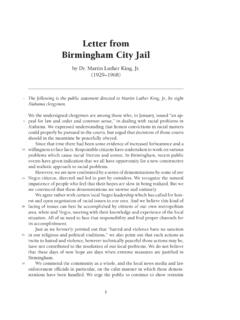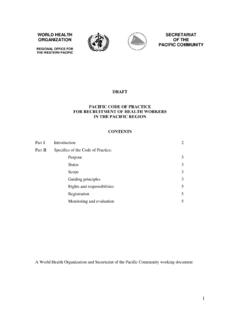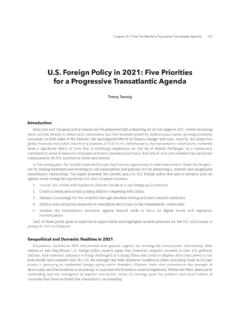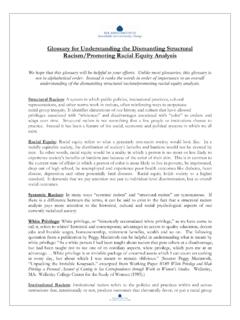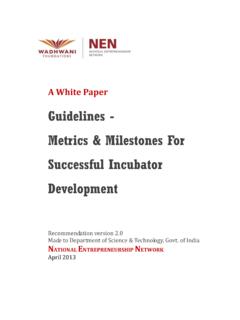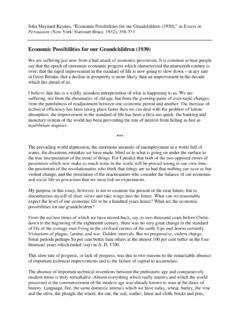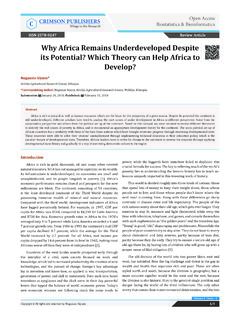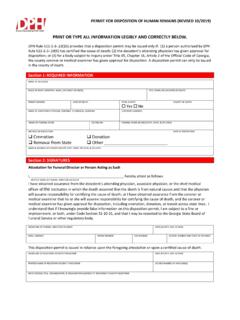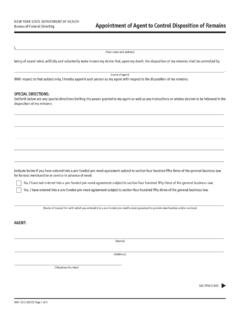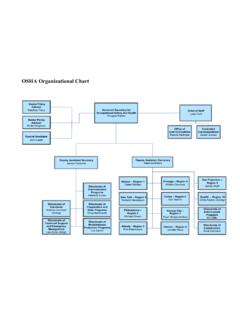Transcription of The Link Between Wages and Productivity Is Strong
1 168 Part III: Promoting Private Sector Wage Growth and Job CreationThe Link < Strong >BetweenStrong > Wages and < Strong >ProductivityStrong > Is StrongAUTHORM ichael R. Strain*, American Enterprise Institute (AEI) and Institute for the Study of Labor (IZA)* Email: I am grateful to Duncan Hobbs and Adele Hunter for excellent research assistance. Any opinions or conclusions expressed are mine alone, and do not necessarily reflect the views of the Aspen Institute, or members of the Aspen Economic Strategy Link < Strong >BetweenStrong > Wages and < Strong >ProductivityStrong > Is Strong 169 ABSTRACTMuch of the public debate in recent years suggests that Wages are not primarily determined by < Strong >ProductivityStrong > .
2 Indeed, the argument that the link < Strong >BetweenStrong > compensation and < Strong >ProductivityStrong > has been effectively severed is commonly made. In this paper, I first discuss the wage-setting process and the conceptual issues that are of critical importance to any empirical investigation of the link < Strong >BetweenStrong > compensation and < Strong >ProductivityStrong > . I then highlight some recent evidence suggesting that, contrary to the current narrative in some policy circles, the link < Strong >BetweenStrong > < Strong >ProductivityStrong > and Wages is How Should We Think About Wages ?
3 Adam Smith s invisible hand is alive and well in the textbook understanding of Wages . Workers who need jobs in order to generate earnings to purchase goods and services enter the labor market willing to supply their labor in exchange for a wage above which (or equal to) the rate at which they are indifferent < Strong >BetweenStrong > working and not working. Employers enter the labor market because they need workers to produce goods and services. Assuming the labor market is competitive, firms take the market wage as a given, operating under the assumption that they cannot influence it.
4 They hire workers up to the point at which the additional revenue generated by hiring an additional worker is equal to the wage rate ( , the additional cost of employing that worker).In this simple model, the higher the wage, the greater the number of workers who want to work; the lower the wage, the greater the number of workers firms want to hire. The labor market reconciles these conflicting wants by settling at an equilibrium wage rate a wage rate such that everyone who wants to work (at the equilibrium wage) finds a job, and every firm that wants to hire workers (again, at the equilibrium wage) finds all the workers it wants.
5 At the equilibrium wage, the labor market clears: labor supply (the number of workers who want to work) equals labor demand (the number of workers firms want to hire). A wage rate above the equilibrium wage would result in too many workers seeking too few jobs; a wage rate below would result in the s pause here and note that this is a model of how labor markets work. In reality, the labor market for an industry or a geographic area to say nothing of the labor market as a whole likely never reaches not?
6 Wages may be sticky, in the sense that firms are reluctant to reduce workers nominal pay when market conditions change. (Economists refer to this as downward 170 Part III: Promoting Private Sector Wage Growth and Job Creationnominal wage rigidity. ) Minimum Wages and other labor market regulations may interfere with the ability of the labor market to adjust Wages to the market clearing point where labor supply and demand are equal. International trade and technological advances may frequently change the demand for some types of workers, inhibiting a stable equilibrium from holding.
7 These are just a few of many crucial way the simple textbook model abstracts from reality is by assuming that firms typically face a market wage that they must take as given. In actual labor markets, firms often have some control over the Wages they offer to their workers labor markets deviate from the perfectly competitive standard textbook treatment. For example, firms in some locations and industries may have to increase their wage offering in order to attract additional workers. (This is an implication of the traditional understanding of monopsony power in the labor market.)
8 These firms might be seeking workers who have a hard time changing jobs, such that higher Wages are required to induce mobility. Firms that have a hard time monitoring their workers might pay higher Wages in order to increase the costs workers face from slacking off and potentially losing a relatively well-paying job. Or firms might pay a higher wage to workers in order to increase their < Strong >ProductivityStrong > and reduce turnover and the costs associated with it. (Implications of efficiency wage theory.)
9 Businesses with monopoly power, meanwhile, face less incentive to hold down costs and may pay higher Wages as a , Wages in many firms are also in part the result of a bargaining process < Strong >BetweenStrong > firms and workers. If firms have increasing bargaining power, then they will be able to push worker Wages to the lowest wage workers will given these real-world considerations, the textbook model is extremely useful because it highlights the central role < Strong >ProductivityStrong > plays in wage offerings. Intuitively, this link should be Strong : If a worker can only produce, say, $15 per hour of revenue for his employer, then why would his employer pay him more than $15 per hour?
10 And if a worker generates $15 per hour in revenue, then why would she accept a wage less than $15 per hour? The relationship < Strong >BetweenStrong > < Strong >ProductivityStrong > and Wages Wages equal marginal revenue product also has attractive moral properties. If the relationship is Strong , then workers are being paid, in a sense, what they are worth to the my view, it is most useful to think of Wages as being determined by a combination of competitive market forces, bargaining power, and institutions. Worker < Strong >ProductivityStrong > is the baseline for which Wages are determined.
